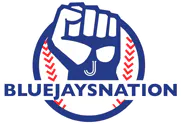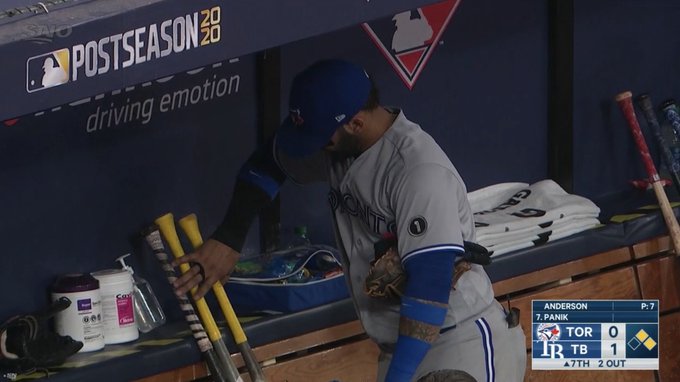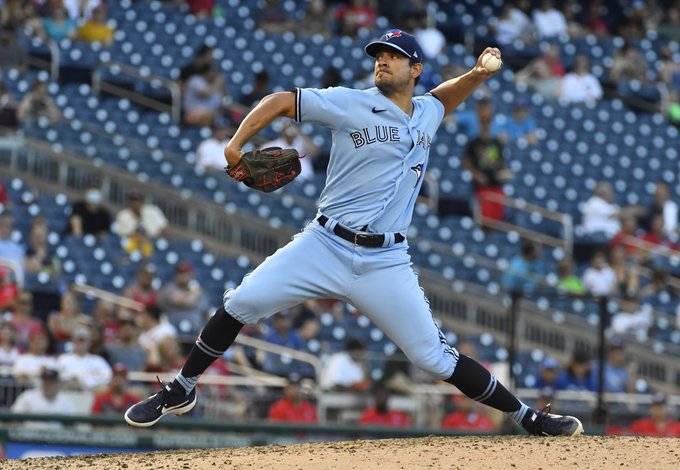Looked as though Jonathan Villar picked up his equipment and left the dugout after the #BlueJays pinch hit for him in the top of the seventh
Trade deadline additions that haven’t worked out for the Blue Jays in recent memory
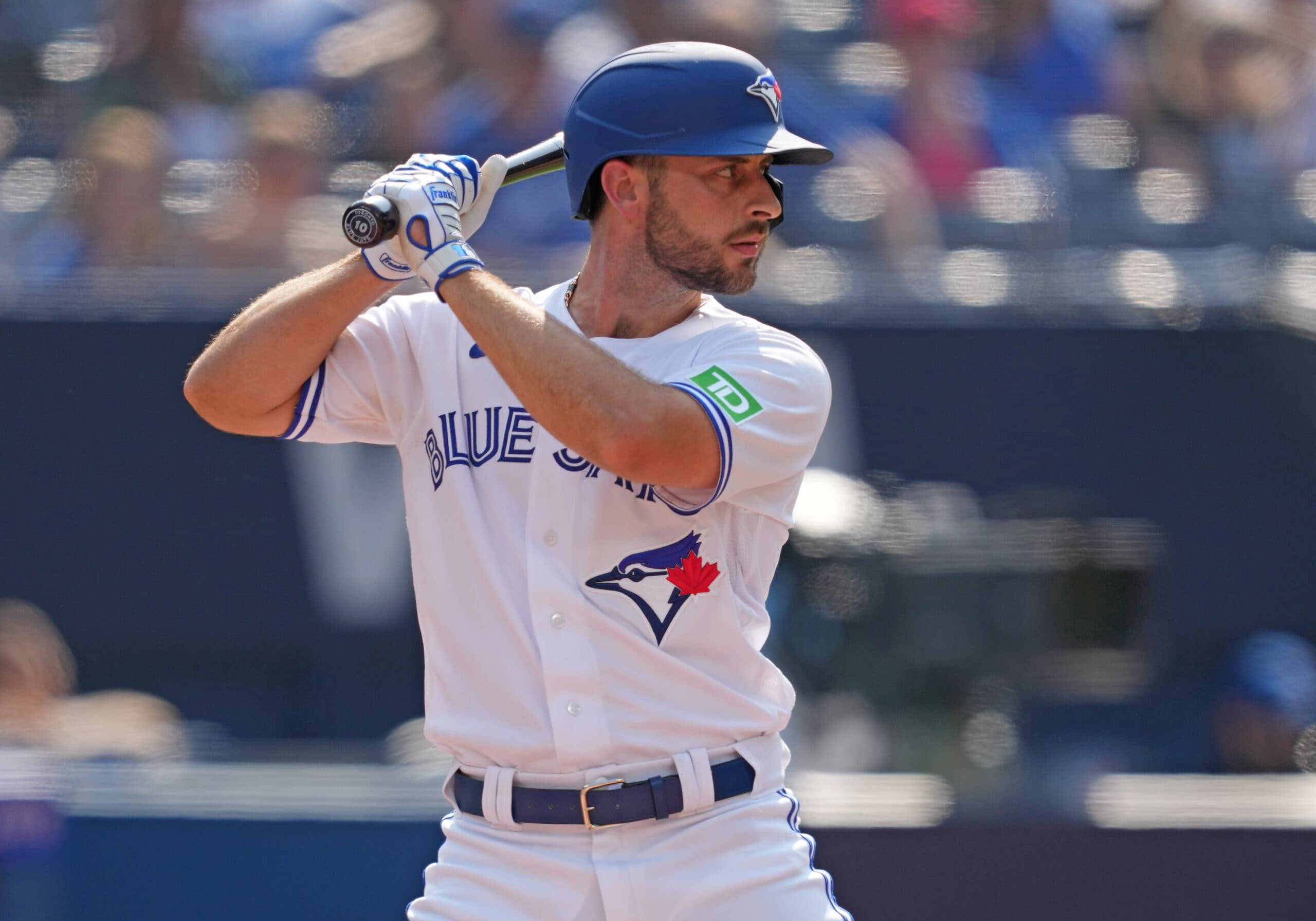
Photo credit: Nick Turchiaro-USA TODAY Sports
Aug 21, 2023, 07:00 EDTUpdated: Aug 20, 2023, 22:27 EDT
Since Ross Atkins and Mark Shapiro took office for the Toronto Blue Jays, the organization has made the postseason on three separate occasions: 2016, 2020, and 2022. While the front office inherited a veteran roster to round out the 2016 season, a rebuild was on the horizon for the latter half of the 2010s and since 2020/2021, the club has started to creep back into playoff contention by utilizing a homegrown core of prospects mixed with veteran free agent talent, starting with the Hyun Jin Ryu signing roughly four years ago.
While the club hasn’t won a postseason game since 2016, Atkins has done his fair share of deals over the years to try and improve the roster, whether it be prospect acquisitions or controllable players early in his tenure or more veteran players, which fans have seen more recently given the club’s position for playoff contention. Regardless of your perception of Atkins and the front office, the stats speak for themselves overall when it comes to trade outcomes; you win some, you lose some.
Over the past few seasons, we have seen the team make some noise at the trade deadline, geared more toward trading away prospects for MLB talent, including acquiring José Berríos, Whit Merrifield, Mitch White, and Jordan Hicks to name a few. Not every deal has been a win for the club, with the Jays most recently designating Paul DeJong for assignment, who was acquired just 19 days ago from the Cardinals and struggled mightily at the plate.
With this in mind, let’s dive back into the recent Blue Jays trade deadline history and look at some trades that either didn’t ultimately work out in the club’s favour (let’s say the 2020 trade deadline is the limit).
Jonathan Villar
During the condensed 2020 season, the trade deadline was moved to the back end of August as teams were only slated to play 60 games that year, with the Blue Jays calling Florida home that season given the border constraints related to COVID-19.
With the club in the midst of playoff contention, Ross Atkins decided to call up the Florida Marlins and acquired infielder Jonathan Villar in exchange for prospect Griffin Conine, a second-round pick of the Jays back in 2018.
A pure rental acquisition considering he was a looming free agent, Villar’s time with the Blue Jays was marred in a struggling bat and multiple baserunning miscues, as the switch-hitter got picked off multiple times while going 13 for 69 at the plate (.188).
As a member of the Jays, Villar posted a .481 OPS through the regular season and went 0 for 2 in the postseason in the AL Wild Card series against the Rays, famously leaving the Jays’ dugout during game two and taking his equipment with him. He did not make nearly the impact the club was hoping for down the stretch for the Jays, especially since Bo Bichette spent roughly a month on the IL with a knee sprain that year.
The Dominican product would join the New York Mets the following offseason.
On the flip side, outfielder Griffin Conine has progressed up the Marlins farm system and has spent most of the 2023 season in Double-A but earned a recent promotion to Triple-A Jacksonville back on August 8th. Since joining the Jumbo Shrimp, Conine has amassed a .318 average through 22 at-bats and has one home run on record while splitting time in the corner outfield spots.
Brad Hand
With an overstock of catching prospects and a need for additional relievers during the 2021 season, the Jays’ front office put in a call to the Washington Nationals and dealt catcher Riley Adams in exchange for veteran left-hander Brad Hand on July 29th.
At the time of the trade, Hand owned a 3.59 ERA through 41 outings, racking up 21 saves through 26 opportunities and was holding opponents to a .203 average. Those stats did not translate over to the Jays, as the left-hander struggled through 11 appearances, allowing seven earned runs off of 13 hits and three home runs while striking out just five batters. Most notably, in his second outing with the Jays, Hand entered in the tenth inning and surrendered three runs, including a two-run shot to Jose Ramirez that cost them the game.
Fast forward to the end of August and the Jays elected to DFA the left-hander, with the New York Mets picking him up on waivers shortly after. A rough month for a veteran left-hander who couldn’t help the Jays in their quest to make the postseason that year.
Blue Jays Designate Brad Hand For Assignment mlbtraderumors.com/2021/08/blue-j…
In Washington, has split the past two seasons between the big leagues and Triple-A and has amassed a .234/.320/.411 slash line with 11 home runs and 39 RBIs to the tune of a .731 OPS. Behind the plate, Adams has thrown out just 14 of 98 base stealers (14%) with just five errors through 110 games.
Mitch White
Last season, the uncertainty of Yusei Kikuchi as a rotation option came to a boil at the trade deadline and the Jays front office swung a deal with the Los Angeles Dodgers, acquiring right-hander Mitch White and infield prospect Alex De Jesus in exchange for prospects Nick Frasso and Moises Brito.
While his first three starts for the Blue Jays were fine, the wheels quickly fell off the rails and White struggled down the stretch, allowing five or more earned runs over his next seven games producing a 9.71 ERA and a 4.33 FIP during that time that eventually led to him being dropped from the AL Wild Card roster. Heading into the 2023 season, White was expected to compete with Kikuchi for the fifth rotation spot but multiple injuries delayed his Spring Training ramp-up and regular season start to mid-June when the club called him up after his rehab appearance time limit was reaching an end.
The trade is official: #BlueJays acquire: RHP Jordan Hicks Cardinals acquire: RHP Sem Robberse RHP Adam Kloffenstein Mitch White has been DFA'd to make room on the 40-man.
Now in the bullpen, the woes continued for White, as the right-hander worked to a 7.11 ERA through 10 appearances while seeing his walk rate climb to 5.0 and generating a 1.737 WHIP that had fans calling for the California product to be DFA’d. That day would come just before the 2023 trade deadline, as the club would DFA White after trading for Cardinals reliever Jordan Hicks. The right-hander is currently in Buffalo after going unclaimed through waivers.
Heading to the Dodgers was prospect pitcher Nick Frasso, who was coming back from elbow surgery that limited him to just three outings in 2021, a year after he was drafted in the fourth round by the Blue Jays. Armed with a plus fastball that can hit triple digits on the radar gun, Frasso joined the Dodgers and took off, posting a 1.59 ERA through two starts in High-A before being promoted to Double-A to finish out the year. There, Frasso made four starts and allowed seven earned runs through 11 2/3, with two outings seeing all of the runs on the board while his other two were shutouts through a collective 6 1/3 innings.
For the 2023 season, Frasso returned to Double-A and through 20 starts, the California product owns a 4.00 ERA with an 11.5 K/9 and 1.22 WHIP through a career-high 69 2/3 innings. He is currently ranked as the Dodgers’ #4 top prospect and is ranked #69 out of the entire MLB.
The one positive for the Jays from this deal is De Jesus, who is holding his own in High-A Vancouver so far this season with a .813 OPS and splitting time between shortstop and third base. The righty-batter is ranked #20 on the Blue Jays top prospect list.
Paul DeJong
Heading into this year’s trade deadline, the Blue Jays were in need of a right-handed bat that could punish lefty pitchers, as the current Jays roster was struggling against the southpaws and the internal options were a risky move to lean on looking forward. With this in mind, the Jays decided to make a third trade with the St. Louis Cardinals this summer, trading away prospect Matt Svanson and acquiring veteran shortstop Paul DeJong in exchange.
On the surface, the deal didn’t make a ton of sense from an offensive standpoint given DeJong was struggling to the tune of a .710 OPS and the Florida product was known more for his glove, which the Jays already had in Santiago Espinal on the bench. Under the hood is where DeJong set himself apart, as the right-handed bat was putting forth a .266/.368/.453 with a 129 wRC+ through 76 plate appearances prior to joining Toronto, and combined with a Bo Bichette knee injury just before the deadline, and the Jays pulled the trigger on the Cardinals shortstop.
What transpired was a collapse of sorts offensively for DeJong, as he struggled to put the ball in play and saw his strikeout rate rise from the already high 28.4% he put forward with St. Louis. Through 44 plate appearances, DeJong collected just three hits with zero extra-base hits, zero RBIs, and zero walks while striking out 40.9% of the time. While his defense was solid, DeJong just wasn’t able to put the ball in play, and once Bichette was healthy and ready to go, the Blue Jays made the somewhat surprising decision to DFA the veteran infielder, which is where he currently sits today.
For the Cardinals, since acquiring Svanson, the right-handed reliever has not found the same success with the organization’s Double-A affiliate (albeit the small sample size). Through five outings, the Illinois product has allowed at least one earned run in four of five games and has seven earned through 7 2/3 with his new club while striking out seven batters compared to one walk. This is in stark contrast to his earlier results this season, as the 24-year-old was dealing in High-A Vancouver to the tune of a 1.23 ERA through 24 relief appearances prior to the trade.
ARTICLE PRESENTED BY BETANO
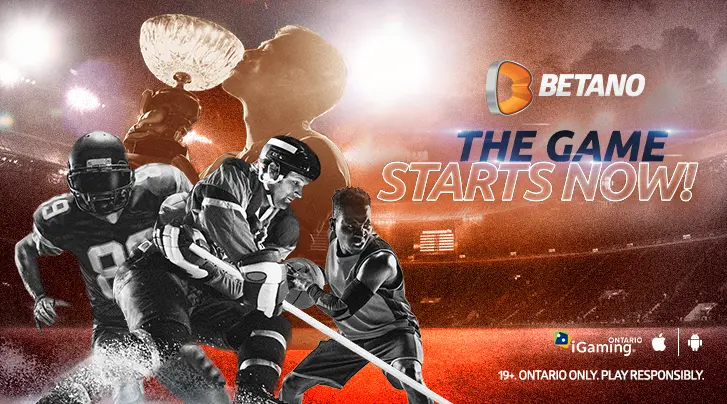
Breaking News
- Former Blue Jays top prospect Orelvis Martinez receives non-roster invitation to attend Nationals’ spring training camp
- Blue Jays: Mark Shapiro signs five-year extension
- Exploring George Springer’s future with the Blue Jays beyond 2026
- Which Blue Jays prospect will debut first in 2026?
- Canadian Sean Duncan ranks 77th on MLB Pipeline’s first Top 100 draft-eligible prospects list for 2026
